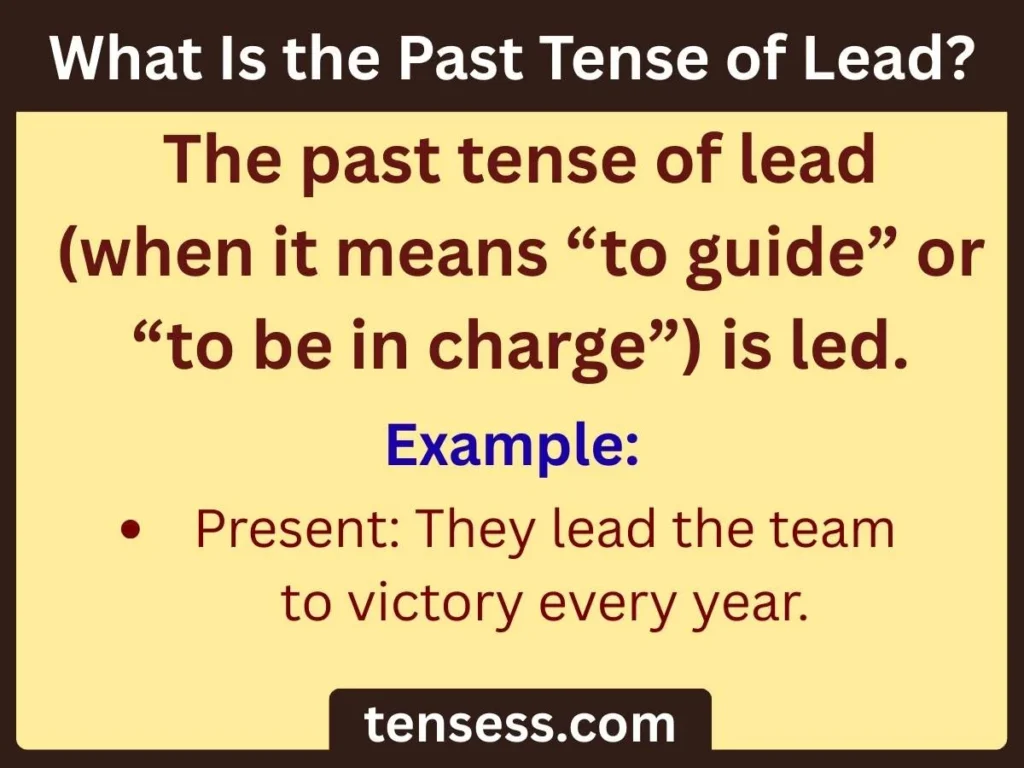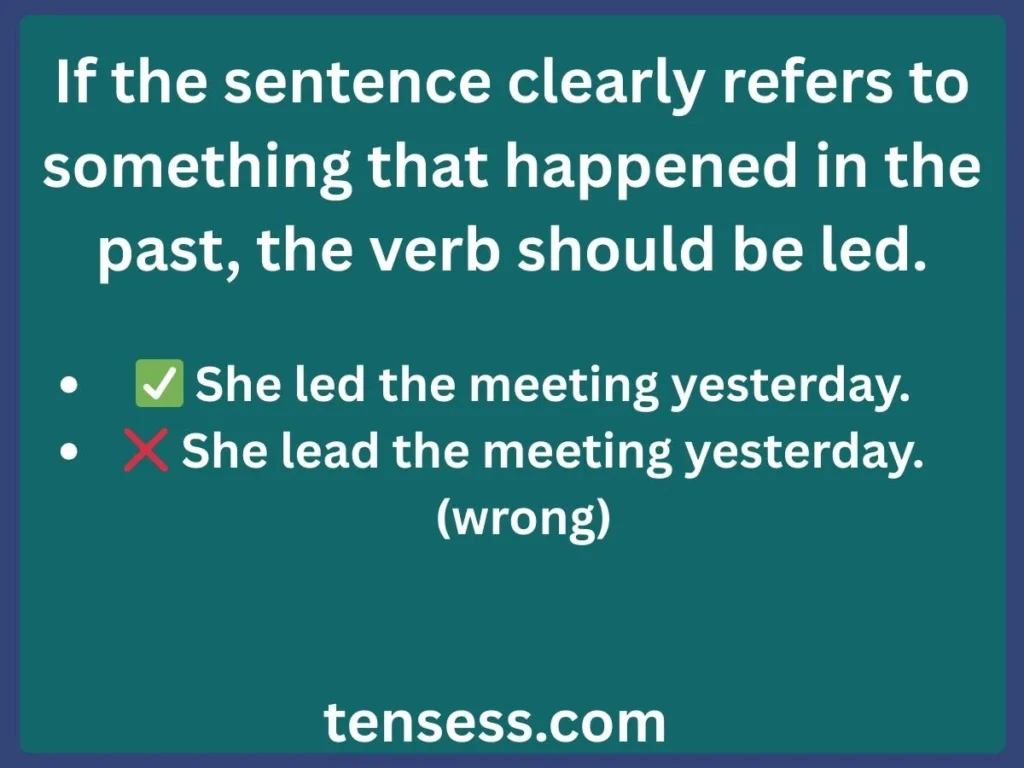Understanding the past tense of lead is essential for students, language learners, writers, and grammar enthusiasts aiming to improve their English skills.
The verb lead can be tricky due to its irregular past tense, often confused with a similar-sounding word. In this beginner-friendly guide, we’ll explore the past tense of lead, its definition, conjugation, and real-life applications.
If you’re writing a story, preparing for an English test, or polishing your grammar, this article will help you use led (the correct past tense) confidently.
We’ll cover sentence structures, common mistakes, and practical exercises to make learning engaging and effective.
By the end, you’ll have a clear grasp of how to use led correctly and avoid pitfalls.
Let’s dive into the world of verb tenses and make grammar fun and accessible!
What Is the Past Tense of Lead?

The past tense of lead is led (pronounced /lɛd/). Unlike the present tense lead (pronounced /liːd/), which means to guide or direct, led describes actions that have already happened. It’s an irregular verb, meaning it doesn’t follow the standard “-ed” ending for regular verbs like “walk” (walked).
Recognition

To recognize led, listen for its distinct pronunciation and context. It often appears in sentences describing past leadership, guidance, or direction. For example, “She led the team to victory.” Be cautious not to confuse it with lead (pronounced /lɛd/), a noun referring to a metal.
Structure of Sentence
A sentence using led typically follows this structure:

Formation
The past tense of lead is formed by changing lead to led without adding auxiliary verbs for simple past tense. In perfect tenses, auxiliary verbs like had (past perfect) or has/have (present perfect) are used, e.g., “She had led the project.”
Verbs
Lead is an irregular verb. Its forms are:
- Present: lead (/liːd/)
- Past: led (/lɛd/)
- Past Participle: led
Helping Verbs
In simple past tense, no helping verbs are needed. For compound tenses:
- Past Perfect: “had led” (e.g., “They had led the campaign.”)
- Present Perfect: “have/has led” (e.g., “She has led successfully.”)
Define the Verb in That Specific Tense
In the past tense, led means guiding, directing, or being in charge of something in the past. It conveys completed actions, like leading a team or a path.
Regular or Irregular?
Lead is an irregular verb because it doesn’t follow the standard “-ed” ending. Instead, it changes to led for both past tense and past participle.
10 Simple Sentence Examples
- I led the hiking group through the forest.
- She led the meeting with confidence.
- He led the choir during the concert.
- We led the project to success last year.
- They led the protest peacefully.
- You led the discussion effectively.
- It led us to a hidden treasure.
- The coach led the team to victory.
- The guide led tourists around the city.
- The teacher led the class in a debate.
How to Conjugate the Past Tense of Lead
Conjugating led in the simple past tense is straightforward since it remains led for all subjects. Here’s how it works:
- Use led for all subjects (I, you, he, she, it, we, they).
- No auxiliary verbs are needed in simple past.
- For past perfect, use “had led” (e.g., “I had led”).
- For present perfect, use “has/have led” (e.g., “She has led”).
- The form led never changes based on singular/plural.
- Use led in active voice sentences (e.g., “He led the team”).
- In passive voice, use “was/were led” (e.g., “The team was led”).
- Ensure proper subject-verb agreement in compound tenses.
- Avoid adding “-ed” to lead; it’s always led.
- Practice with varied subjects to master usage.
Conjugation Table
| Subject | Simple Past | Past Perfect | Present Perfect |
| I | led | had led | have led |
| You | led | had led | have led |
| He/She/It | led | had led | has led |
| We | led | had led | have led |
| They | led | had led | have led |
Spelling Changes or Irregularities
- The main irregularity is the change from lead (/liːd/) to led (/lɛd/).
- Avoid confusing led with lead (/lɛd/), the metal.
- No additional suffixes or spelling changes occur.
Examples of Past Tense of Lead Sentences
- I led a workshop on creative writing last week.
- You led the negotiations successfully.
- She led the charity drive for the community.
- He led the expedition to the mountains.
- It led to unexpected discoveries.
- We led the campaign for eco-friendly policies.
- They led the team to a championship win.
- The manager led the staff through changes.
- The dog led us to the lost child.
- The professor led a fascinating lecture.
Common Mistakes with Past Tense of Lead
- Confusing “led” with “lead”: Using lead (/liːd/) instead of led (e.g., “He lead the team” is incorrect).
- Fix: Always use led for past tense.
- Mispronouncing “led”: Saying /liːd/ instead of /lɛd/.
- Fix: Practice pronunciation with audio tools.
- Using “leaded”: Adding “-ed” to form leaded (incorrect).
- Fix: Remember lead is irregular; use led.
- Mixing tenses: Using led in present contexts (e.g., “She led the team tomorrow”).
- Fix: Use lead for present/future.
- Confusing with the noun “lead”: Writing “The pipe was made of led” (incorrect).
- Fix: Use lead (/lɛd/) for the metal.
- Overusing auxiliary verbs: Saying “She had led the meeting yesterday” unnecessarily.
- Fix: Use simple past (led) for single past events.
- Spelling errors: Writing “lead” instead of led in past tense.
- Fix: Double-check spelling in writing.
- Incorrect passive voice: Saying “The team was lead” instead of “was led.”
- Fix: Use led in passive constructions.
- Ignoring context: Using led for non-guidance actions (e.g., “He led the book”).
- Fix: Ensure led fits the meaning of guiding.
- Not practicing enough: Forgetting the correct form due to lack of use.
- Fix: Practice with exercises and quizzes.
Related Verbs and Synonyms for Lead
Synonyms for lead (in the sense of guiding) include:
- Guide
- Direct
- Steer
- Conduct
- Escort
- Head
- Pilot
- Usher
- Shepherd
- Manage
Verbs Often Confused with Lead
- Lead (/lɛd/): The noun meaning a metal.
- Read: Often confused due to similar spelling (past tense: read /rɛd/).
- Example: “She read a book” vs. “She led a team.”
Sentence Comparisons
- Lead (present): “I lead the group today.”
- Led (past): “I led the group yesterday.”
- Read (past): “I read a book yesterday.”
Tips to Practice Using Past Tense of Lead
- Write 5 sentences daily using led with different subjects.
- Read books and highlight sentences with led.
- Use flashcards to memorize lead (present) vs. led (past).
- Practice speaking sentences with led to master pronunciation.
- Take online quizzes on irregular verbs.
- Create a story using led in various contexts.
- Use grammar apps to check your use of led.
- Join English forums to discuss verb tenses.
- Watch videos explaining irregular verbs like lead.
- Teach a friend about led to reinforce learning.
Frequently Asked Questions
- What is the past tense of lead?
- The past tense of lead is led (/lɛd/).
- Is “lead” ever used in the past tense?
- No, lead (/liːd/) is present tense; led is past tense.
- Why is “leaded” incorrect?
- Lead is irregular, so it becomes led, not leaded.
- How do I pronounce “led”?
- It’s pronounced /lɛd/, rhyming with “bed.”
- Can “led” be used in passive voice?
- Yes, e.g., “The team was led by her.”
- What’s the difference between “lead” and “led”?
- Lead is present tense; led is past tense/participle.
- Is “lead” a regular verb?
- No, it’s an irregular verb.
- How do I avoid confusing “lead” and “led”?
- Practice pronunciation and context-based exercises.
- What are synonyms for “led”?
- Guide, direct, steer, etc.
- How can I practice using “led”?
- Write sentences, take quizzes, and use grammar tools.
Exercises
- Fill in the blank: She ___ the team to victory. (Answer: led)
- Correct the sentence: He lead the group yesterday. (Answer: He led)
- Write a sentence using led with “I” as the subject.
- Identify the error: They had lead the project. (Answer: Use led)
- Convert to past perfect: She leads the choir. (Answer: She had led)
- Use led in a passive voice sentence.
- Write a sentence with led and an adverb.
- Replace led with a synonym in: He led the expedition.
- Create a sentence using led about a school event.
- Combine led and guide in one sentence.
Quizzes
- What is the past tense of lead? (A) Leaded (B) Led (C) Lead (Answer: B)
- True/False: Led is pronounced /liːd/. (Answer: False)
- Fill in: I ___ the meeting last week. (Answer: led)
- Which is correct? (A) She lead (B) She led (Answer: B)
- What’s the past perfect of lead? (Answer: had led)
- Correct the error: He leaded the team. (Answer: He led)
- Choose the synonym for led: (A) Follow (B) Guide (Answer: B)
- Is lead regular or irregular? (Answer: Irregular)
- Write a sentence using led with “they.”
- Identify the tense: She has led the group. (Answer: Present Perfect)
Conclusion
Mastering the past tense of lead—led—is a valuable skill for clear communication.
By understanding its irregular verb nature, practicing conjugation, and avoiding common mistakes like confusing led with lead (/lɛd/), you can enhance your writing and speaking.
This guide has provided verb tense examples, tips, and exercises to make learning engaging.
Whether you’re a student, writer, or language learner, regular practice with led in sentences will build confidence.
Try writing your own sentences or use a grammar checker to refine your skills.
Share your progress in the comments or explore more verb conjugation resources to keep improving.
Start using led today and lead your grammar game to the next level!



